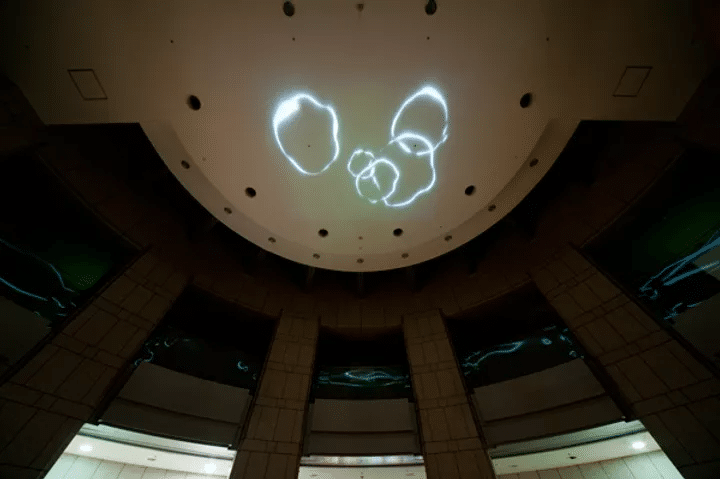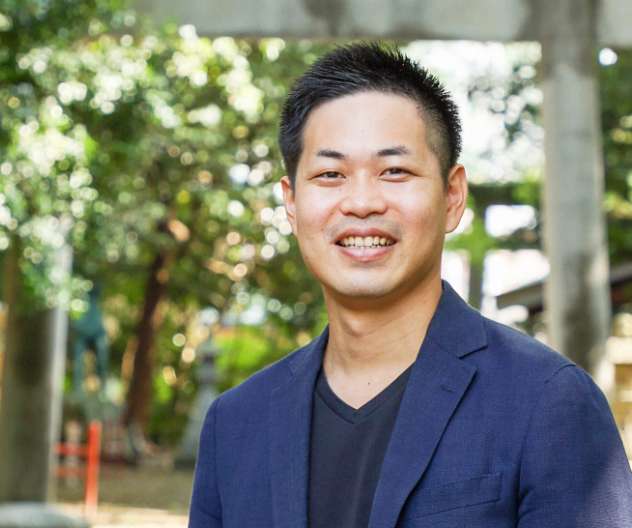Columns

Kinan Art Week Artist Interview: Nobuhiro Shimura
We are pleased to present a series of “Artist Interviews” introducing the exhibiting artists of Kinan Art Week.
<Our guest this time.>
Video artists
Nobuhiro Shimura
Born 1982 in Tokyo, Japan. Completed a postgraduate course in imaging Arts and Sciences at Musashino Art University.
The theme of his work is “Let there be light”. He has created many works that make the most of the characteristics of light, which cannot be touched and does not leave any form. In 2007 he won the Grand Prix in the Interactive/Installation category at the NHK Digista Awards 2007, and in 2011 he was awarded the Koganecho Bazaar Prize by the local community.
https://www.nshimu.com/
<Interviewer>

Yuto Yabumoto
Kinan Art Week Executive Committee Chair
<Editing>
Kinan Editor by TETAU
https://good.tetau.jp/
<Table of contents>
1. Gather the scattered things
2. “Bundling” the potential of the work and the local character of Kinan
1. Gather the Scattered Things
Source: https://www.nshimu.com/works-jewel
Yabumoto:
Thank you very much for your time today. Can you tell us a bit about the concept behind Jewel?
Mr Shimura:
I left graduate school in 2007. “Jewel” is a work from my early days, made in 2009.
At that time, I didn’t have a specific idea of what I wanted to express. I used to go to the places where my work was going to be exhibited beforehand, and I was inspired by the background and history of the place, what I could feel and hear there.
The exhibition space for Jewel was an art space in Harajuku called Vacant. I was surprised when I went to see it. It was the site of a second-hand clothes shop I used to go to when I was in high school. “This is the place to do it!” I thought.
Yabumoto:
Is that so.
Mr Shimura:
In my memory, it was a place with a strong image of a second-hand clothes shop. And the place was Harajuku. The first thing I wanted to do with this work was to make something related to clothes and second-hand clothing.
Yabumoto:
So you decided to go with buttons.
Mr Shimura:
That’s right. I also wanted to bring out the characteristics and possibilities of the film.
For example, I think that sculptors and people who express themselves in three dimensions are always thinking about what they can only create with that material. I work with images, with light. It is characterized by the fact that it has no fixed size or shape as an object. This may be a disadvantage when compared to three-dimensional work, but I dare to see it as an advantage.
Yabumoto:
Something that seems to stay, but doesn’t.
Mr Shimura:
In short, the light projected by the projector is itself a work of art, so you can’t touch it, and it doesn’t leave any form behind. I thought that if I could make the most of this merit, it would be interesting to have works in places where they would not normally be displayed.
Yabumoto:
I see.
Mr Shimura:
At Vacant, I proposed to project a video onto the stairs and make the stairs themselves my artwork. It’s a place that’s not suitable for three-dimensional works or paintings, but it’s possible for video works. With the memory of a second-hand clothes shop, I thought about what would be the best way to project images onto people when they pass by, so I used “buttons” as a motif.
I’m projecting a video onto the stairs, but what I really wanted to do was to use the human body as a screen. The artwork is made complete when people pass through it.
Yabumoto:
Another question I would like to ask is the origin of the name of your work. Why did you choose the name “Jewel” for a button?
Mr Shimura:
In my early works, I used to name the motifs themselves rather straightforwardly, like “red shoes”, “ribbon” or “red carpet”. But for the title of this piece, “Button” didn’t feel right. In fact, the English word “jewel” also has the verb meaning “to scatter”, so I chose “jewel”.
Yabumoto:
I see! Buttons also have the meaning of “joining” fabrics together, don’t they?
“Gathering the scattered”. The Shinjyu Building used to be a place where young people used to gather. Now they’re coming together again. It’s already interesting enough.
Mr Shimura:
Thank you very much.
On the occasion of my solo exhibition at the Chiba Prefectural Museum of Art in 2019, I projected this work at the entrance as a greeting piece.
Yabumoto:
We hope to be able to do something like that in this Shinjyu building, if it is technically possible.
2. “Bundling ” the Potential of the Work and the Local Character of Kinan
Yabumoto:
Next, let’s talk about the pool. This is a projection on the ceiling, isn’t it?
Mr Shimura:
It’s a tricky piece. I’m often asked, “Did you film the bubbles?”, but like the buttons, I use everyday objects to make them. Actually, I’m filming a white rubber band.
Yabumoto:
That’s interesting! Rubber bands are also a way to connect.
Mr Shimura:
Yes, it’s true, it’s a ‘bundle’, something I’ve only just realised after 10 years (laughs).
Yabumoto:
How many bands are you filming?
Mr Shimura:
The video itself is like a lot of bubbles, but I’m filming only one rubber band, and I’m making a composite of it. I submerged the rubber band in the water and moved the surface of the water. When you move the surface of the water, the submerged rubber band moves. The movement created by the fluctuation of the water is the image. I projected it onto the actual space and made it look like bubbles.
Yabumoto:
Why is this title “The Pool”?
Mr Shimura:
The word “pool” has a verb “to accumulate” as well as a noun “a puddle of water” or “a pool in which one can swim”. The ceiling of the Yokohama Museum of Art, where this work was exhibited, no one ever looks at it. If you project an image onto that ceiling and create a point of view, everyone gathers underneath it and looks up. That’s the kind of “pooling” I want to create.
Yabumoto:
I see, you wanted to project it on the ceiling.
Mr Shimura:
Also, the word “pool” has with it the image of water.
Yabumoto:
Tanabe City is the gateway to the sea and a post town on the Kumano Kodo. It was a place for people to “gather”. How are the bubbles seen?
Mr Shimura:
They appear and disappear, so I thought it would be natural to animate them.
Yabumoto:
In haiku, for example, it is a sadness, something that disappears. The world view of impermanence. And it’s a circle.
Mr Shimura:
What’s more, I think it works because it’s not coloured. It’s a rubber band, so it could have been brown. But by keeping it white and not giving too much information, it allows the viewer to imagine all sorts of things. The choice of white was the right one.
Yabumoto:
It’s interesting. ”Bubbles”, “water”, “bundle”, “pool”. Those words are the key words.
What is it that binds us together? What is the place where we can gather? With Shimura’s work, we may be able to ask these questions.
Mr Shimura:
I think it’s good for the work that the potential of the work and the local character of Tanabe are connected. It’s a new reinterpretation.
Yabumoto:
It would be a waste to discuss this with the time we have left, so I’ll leave it at that.
Thank you very much for your interesting talk today.
